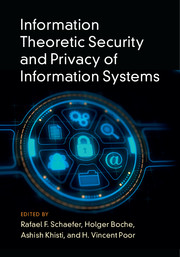Book contents
- Frontmatter
- Contents
- List of Contributors
- Preface
- Part I Theoretical Foundations
- Part II Secure Communication
- 5 Secrecy Rate Maximization in Gaussian MIMO Wiretap Channels
- 6 MIMO Wiretap Channels
- 7 MISO Wiretap Channel with Strictly Causal CSI: A Topological Viewpoint
- 8 Physical-Layer Security with Delayed, Hybrid, and Alternating Channel State Knowledge
- 9 Stochastic Orders, Alignments, and Ergodic Secrecy Capacity
- 10 The Discrete Memoryless Arbitrarily Varying Wiretap Channel
- 11 Super-Activation as a Unique Feature of Secure Communication over Arbitrarily Varying Channels
- Part III Secret Key Generation and Authentication
- Part IV Data Systems and Related Applications
- Index
- References
7 - MISO Wiretap Channel with Strictly Causal CSI: A Topological Viewpoint
from Part II - Secure Communication
Published online by Cambridge University Press: 28 June 2017
- Frontmatter
- Contents
- List of Contributors
- Preface
- Part I Theoretical Foundations
- Part II Secure Communication
- 5 Secrecy Rate Maximization in Gaussian MIMO Wiretap Channels
- 6 MIMO Wiretap Channels
- 7 MISO Wiretap Channel with Strictly Causal CSI: A Topological Viewpoint
- 8 Physical-Layer Security with Delayed, Hybrid, and Alternating Channel State Knowledge
- 9 Stochastic Orders, Alignments, and Ergodic Secrecy Capacity
- 10 The Discrete Memoryless Arbitrarily Varying Wiretap Channel
- 11 Super-Activation as a Unique Feature of Secure Communication over Arbitrarily Varying Channels
- Part III Secret Key Generation and Authentication
- Part IV Data Systems and Related Applications
- Index
- References
Summary
Physical-layer security offers an alternative to cryptology, where instead of using the secrecy keys, randomness of the wireless channel is utilized to conceal information. In this chapter, we give an overview of different state-of-the-art multi-terminal information theoretic models to secure information with varying quality of channel state information at the transmitter. We first introduce the essential elements of information theoretic security, and later on discuss its application from a degrees of freedom viewpoint. In particular, we focus our attention on the models in which the topology of the network is known at the transmitter.
Introduction
Wireless communication has completely revolutionized the lives of common users. Modern communication systems provide high data rates, which allow users to perform different day-to-day tasks wirelessly. For example, users can access their bank account details and monitor their home security remotely. However, due to the broadcast nature of the medium, the information exchange between these communication nodes can be overheard by unintended users in the network. The leakage of information to unintended users may have serious consequences. In this chapter, we intend to answer this fundamental question of how to secure wireless communication.
State of the Art and Preliminaries
In conventional systems, cryptographic encryption is used to conceal information from adversaries. Figure 7.1 shows a simple example which sheds light on the problem of secret key sharing studied in cryptology. The source message at Alice is converted to ciphertext with the help of a secret key which is shared between Alice and the legitimate receiver, Bob. The ciphertext is then communicated over the wireless channel and is received by both Bob and Eve. Upon getting the ciphertext and having access to the secret key, Bob can easily recover Alice's message [1]. It is assumed that Eve, the eavesdropper, is of limited computational complexity or has limited resources. Thus, it is unable to generate all combinations of secret key, and consequently cannot recover Alice's message. In this framework, secrecy relies on the difficulty level of some hard mathematical problem which the eavesdropper is unable to solve due to limited computational resources.
- Type
- Chapter
- Information
- Publisher: Cambridge University PressPrint publication year: 2017

